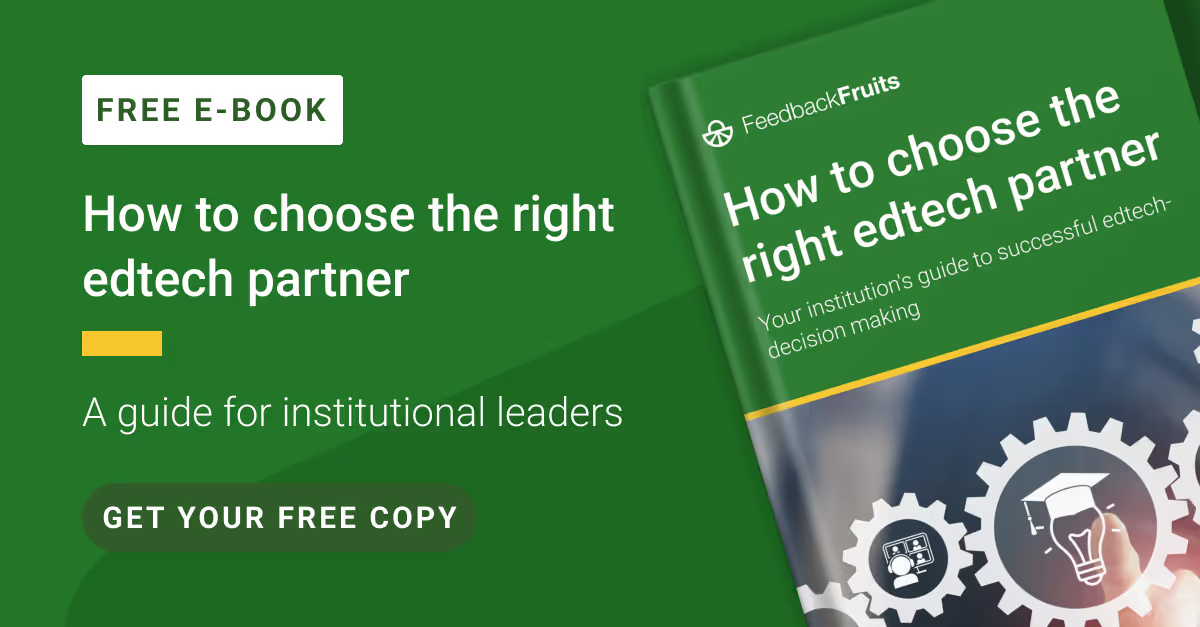How to choose the right edtech partner: 8 factors to consider
Selecting the right edtech vendor requires careful consideration of multiple factors to ensure effect adoption that enhances teaching and learning quality. This article outlines eight crucial factors that institutions should consider when choosing an edtech partner.

To arrive at this vision of “a technology-enabled, sustainable” education that operates effectively while flexibly anticipating and addressing emerging challenges, faculties need to have the ability to evaluate and select a suitable edtech vendor that can enhance their Learning Management Systems (LMSs). Considering the availability of many vendors, there is a need for a holistic framework for edtech decision-making.
From our collaboration and conversation with many institutions around the world, we have come up with 8 key factors to consider when evaluating and choosing an edtech provider.
1 | Institution’s goals and needs
Defining your institution's goals and aligning these with the edtech vendor should always come first before considering other key factors. Once you’ve identified the purpose for using the technology, whether it is facilitating authentic assessment, stimulating collaboration, or increasing student engagement, it is much easier to pinpoint the provider that allows you to achieve the goal.
This can be done by conducting a thorough needs analysis to identify the specific challenges and opportunities within your institution. Engage stakeholders from various departments, including faculty, IT, administration, and students, to gather diverse perspectives and insights.
2 | Functionality and scalability
After identifying your institution’s goals and a suitable edtech vendor, it’s time to check whether they offer sufficient functionalities and scalability to accommodate your institution’s goals.
Aside from scalability across course modalities, class sizes, and subject domains, the edtech provider needs to offer a user-friendly and intuitive interface and multimedia communication for both teachers and students.
3 | Compatibility and integration
It is important to check if the edtech provider offers seamless integration into your native LMS, via either LTI or API integration. Read more on LTI integration and API integration.
These integrations enable automatic group synchronization, single sign-on, automated synchronization of assignment deadlines, and LMS grade book. In other words, if faculties and students can access the tool directly and consistently within LMS, their learning experiences are critically enhanced.
4 | Budget and time
Cost and Time are the next two factors that influence the evaluation and selection of the edtech vendor. The more time and budget required to adopt a teaching tool, the less likely it is for the tool to be chosen. According to Bates (2025), there are several elements that contribute to the cost and time of the technology adoption process, including:
- Development and delivery of study materials and learning activities: The time and effort required to create and facilitate the study materials and learning activities will influence the choice of teaching tools.
- Class size: The more students the course needs to cover, the more time and cost are needed to design the learning activities and facilitate teaching the course.
- Time and effort required to master the tool: The time it takes for teachers to get familiar with the tools can determine the finance needed for training and support, subsequently driving the technology use decision.
5 | Accessibility
Now that you have considered the budget and time element, the next step is to examine whether the tool offers a certain degree of accessibility.
The definition of accessibility is grounded in the Universal Design for Learning (UDL) framework. That is, accessibility refers to the flexible course design to address learner variability and reduce the barriers to learning, and the capacity to meet legislative requirements of specific accessibility needs such as the Web Content Accessibility Guidelines (WCAG) criteria.
6 | Teaching and learning values
When evaluating an edtech vendor, take into account whether it can support the design of a sustainable learning environment, that encourages meaningful interactions, continuous engagement, and feedback, and stimulates active learning.
According to a 2017 study on “EdTech Decision Making in Higher Education”, the most common goal for edtech adoption was to support “a particular pedagogical or assessment model or strategy”. The capacity to enhance pedagogy is reflected through whether the edtech provider can support active learning design and authentic assessment, offer solutions for personalized and inclusive learning, provide easy-to-access oversights, and more.
7 | Timely, sufficient support
Find an edtech provider that actively engages with your faculty and staff by gathering and incorporating their feedback into the products, as well as treating them as partners in enhancing student learning experiences. When a company integrates user feedback into the edtech solution, faculty and staff will be more likely to accept the product and feel more accountable for its success.
Timely, up-to-date, and responsive support for both staff and students is also critical when considering an edtech vendor. Therefore, it is important to check if the Tool provider presents your team with diverse and robust support methods and channels.
8 | Privacy and security
Finally, you shouldn’t overlook the data protection of personal information and intellectual property. So what should you look at when checking whether the edtech provider ensures privacy and security?
- The sign-up/sign-in option evaluates whether the tool requires extra account creation or additional login aside from the LMS login. This is to ensure no disclosure of students’ personal information.
- Privacy, data protection, and rights. Any edtech vendor allows both teachers and students to maintain ownership of their intellectual property while having full control over the use and distribution of the study content.
- Archiving, saving, and exporting Data. Teachers should have the flexibility to monitor the learning analytics while students can access the study content without fear of copyright infringement.
Detailed framework in our ebook - “How to choose the right edtech partner”
For detailed explanation on each of these factors, download our latest ebook. You can also find use cases of successful edtech decision-making and downloadable framework to apply at your institution.

















![[New] Competency-Based Assessment](https://no-cache.hubspot.com/cta/default/3782716/interactive-146849337207.png)










